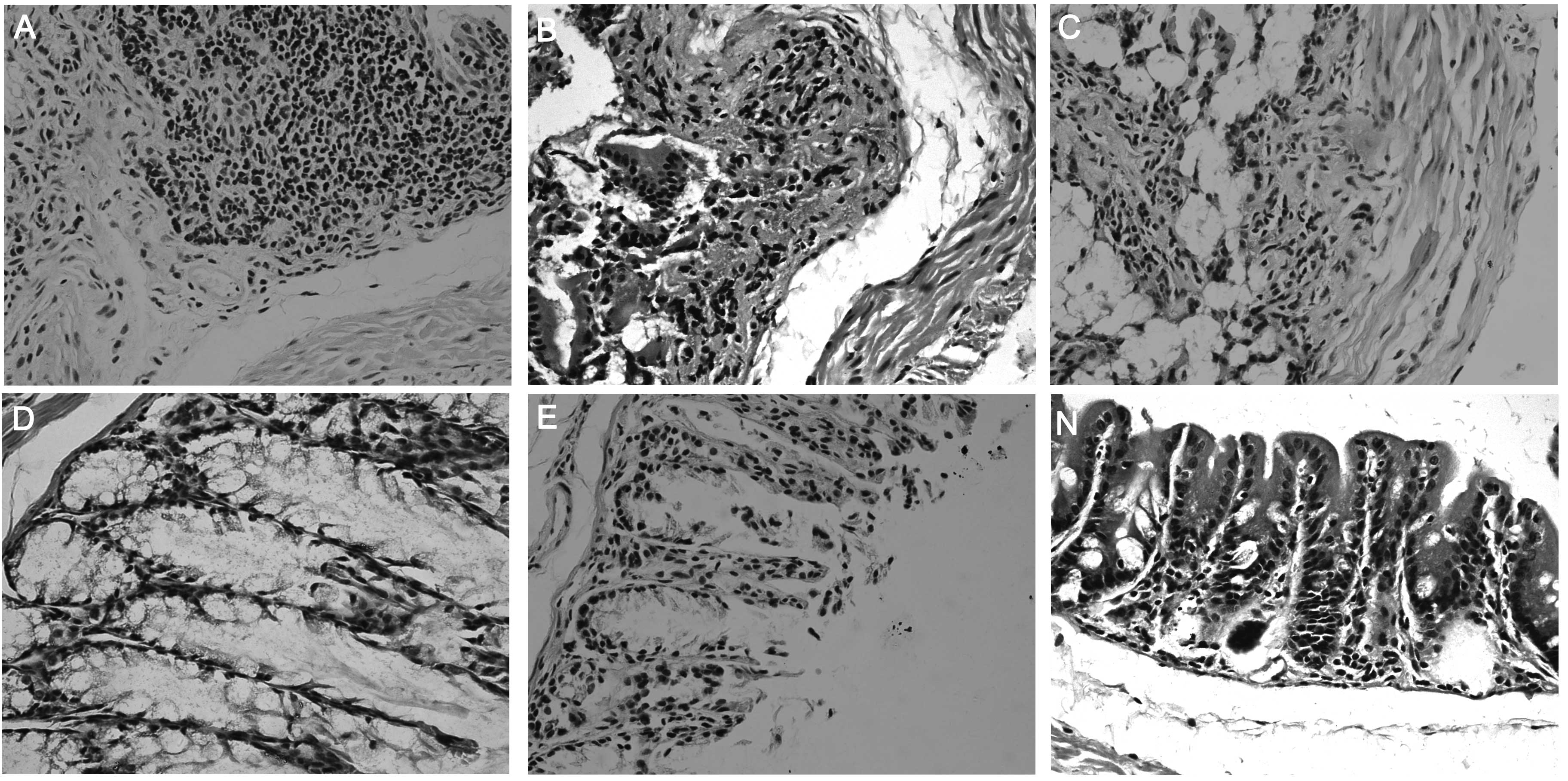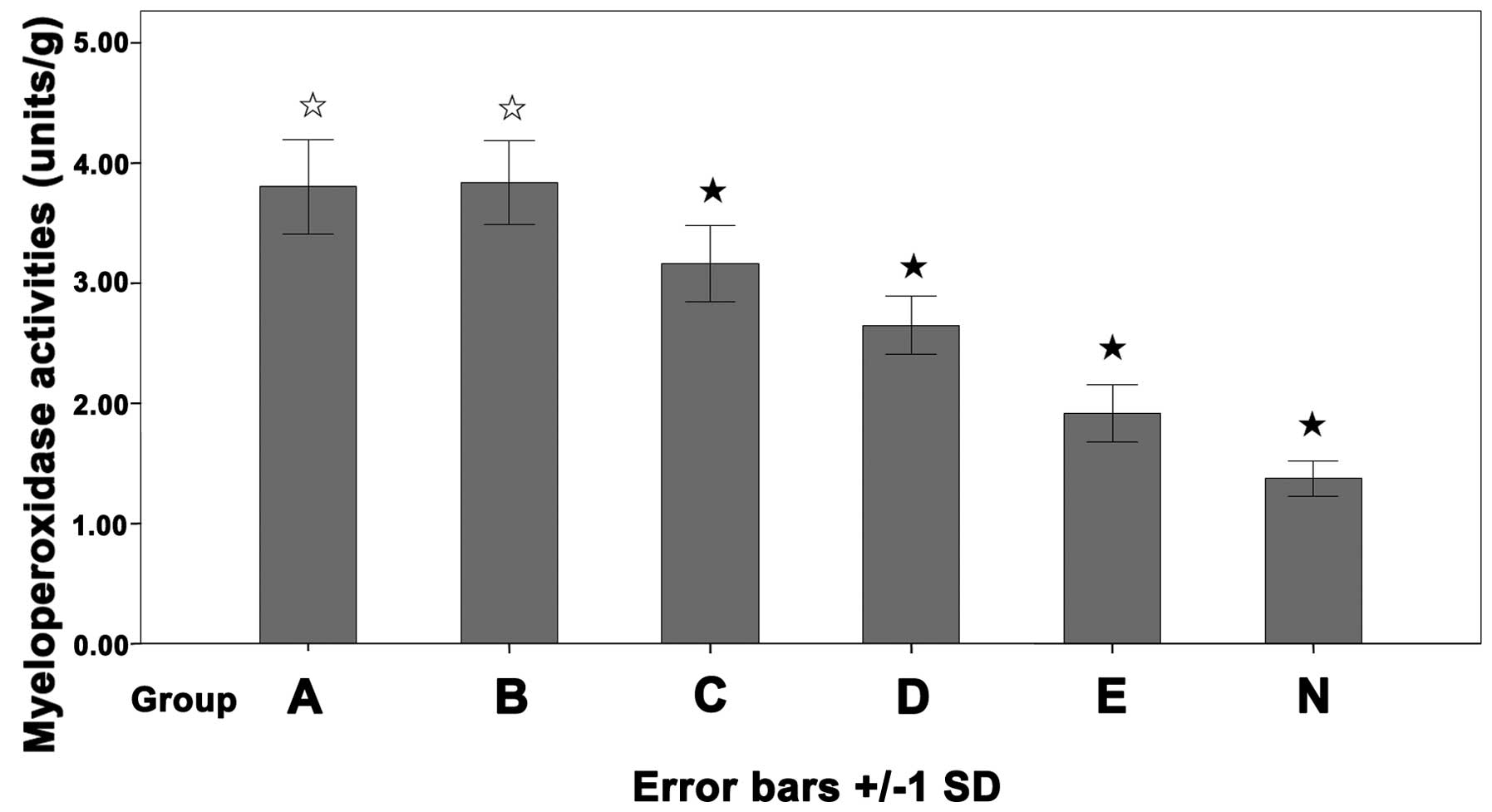|
1
|
Braus NA and Elliott DE: Advances in the
pathogenesis and treatment of IBD. Clin Immunol. 132:1–9. 2009.
View Article : Google Scholar
|
|
2
|
Oliva-Hemker M and Fiocchi C:
Etiopathogenesis of inflammatory bowel disease: the importance of
the pediatric perspective. Inflamm Bowel Dis. 8:112–128. 2002.
View Article : Google Scholar : PubMed/NCBI
|
|
3
|
Siminovitch KA: Advances in the molecular
dissection of inflammatory bowel disease. Seminars Immunol.
18:244–253. 2006. View Article : Google Scholar : PubMed/NCBI
|
|
4
|
Cho JH and Weaver CT: The genetics of
inflammatory bowel disease. Gastroenterology. 133:1327–1339. 2007.
View Article : Google Scholar
|
|
5
|
Abdel-Hady M and Bunn SK: Inflammatory
bowel disease. Current Paediatrics. 14:598–604. 2004. View Article : Google Scholar
|
|
6
|
Toruner M, Loftus EV Jr, Harmsen WS,
Zinsmeister AR, Orenstein R, Sandborn WJ, Colombel JF and Egan LJ:
Risk factors for opportunistic infections in patients with
inflammatory bowel disease. Gastroenterology. 134:929–936. 2008.
View Article : Google Scholar : PubMed/NCBI
|
|
7
|
Melmed GY, Ippoliti AF, Papadakis KA, Tran
TT, Birt JL, Lee SK, Frenck RW, Targan SR and Vasiliauskas EA:
Patients with inflammatory bowel disease are at risk for vaccine
preventable illnesses. Am J Gastroenterol. 101:1834–1840. 2006.
View Article : Google Scholar : PubMed/NCBI
|
|
8
|
Qin F and Huang X: Guanxin II (II) for the
management of coronary heart disease. Chin J Integr Med.
15:472–476. 2009. View Article : Google Scholar : PubMed/NCBI
|
|
9
|
Bai A, Lu N, Guo Y and Fan X: Tanshinone
IIA ameliorates trinitrobenzene sulfonic acid (TNBS)-induced murine
colitis. Diges Dis Sci. 53:421–428. 2008. View Article : Google Scholar : PubMed/NCBI
|
|
10
|
Kang BY, Chung SW, Kim SH, Ryu SY and Kim
TS: Inhibition of interleukin-12 and interferon-gamma production in
immune cells by tanshinones from Salvia miltiorrhiza.
Immunopharmacology. 49:355–361. 2000. View Article : Google Scholar : PubMed/NCBI
|
|
11
|
Yang XZ and Xue XP: Effects of Danshen
injection on NF-κB activation of macrophages. J Liaoning Univ
Tradit Chin Med. 4:184–185. 2007.
|
|
12
|
Dong WY, Hu GZ, Zhang B, Zheng CQ, Chen
SN, Liu WL and Shi YD: Effects of twelve Chinese herbs on human
regulatory T cell differentiation in vitro. World Chinese Journal
of Digestology. 16:2770–2774. 2008.
|
|
13
|
Ye Y: Comparative study on the
determination of salvianolic acids content by colorimetery and
HPLC. J Zhejiang Univ Traditional Chinese Med. 30:350–351.
2006.
|
|
14
|
Neurath MF, Fuss I, Kelsall BL, Stüber E
and Strober W: Antibodies to interleukin 12 abrogate established
experimental colitis in mice. J Exp Med. 182:1281–1290. 1995.
View Article : Google Scholar : PubMed/NCBI
|
|
15
|
Coquerelle C, Oldenhove G, Acolty V,
Denoeud J, Vansanten G, Verdebout JM, Mellor A, Bluestone JA and
Moser M: Anti-CTLA-4 treatment induces IL-10-producing ICOS+
regulatory T cells displaying IDO-dependent anti-inflammatory
properties in a mouse model of colitis. Gut. 58:1363–1373.
2009.PubMed/NCBI
|
|
16
|
Bai A, Hu P, Chen J, Song X, Chen W, Peng
W, Zeng Z and Gao X: Blockade of STAT3 by antisense oligonucleotide
in TNBS-induced murine colitis. Int J Colorectal Dis. 22:625–635.
2007. View Article : Google Scholar : PubMed/NCBI
|
|
17
|
Krawisz JE, Sharon P and Stenson WF:
Quantitative assay for acute intestinal inflammation based on
myeloperoxidase activity. Assessment of inflammation in rat and
hamster models. Gastroenterology. 87:1344–1345. 1984.PubMed/NCBI
|
|
18
|
Hibi T, Ogata H and Sakuraba A: Animal
models of inflammatory bowel disease. J Gastroenterol. 37:409–417.
2002. View Article : Google Scholar
|
|
19
|
Tanchot C, Vasseur F, Pontoux C, Garcia C
and Sarukhan A: Immune regulation by self-reactive T cells is
antigen specific. J Immunol. 172:4285–4291. 2004. View Article : Google Scholar : PubMed/NCBI
|
|
20
|
Thorstenson KM and Khoruts A: Generation
of anergic and potentially immunoregulatory CD25+CD4+ T cells in
vivo after induction of peripheral tolerance with intravenous or
oral antigen. J Immunol. 167:188–195. 2001.PubMed/NCBI
|
|
21
|
Tang Q and Bluestone JA: The Foxp3+
regulatory T cell: a jack of all trades, master of regulation. Nat
Immunol. 9:239–244. 2008.
|
|
22
|
Hori S, Nomura T and Sakaguchi S: Control
of regulatory T cell development by the transcription factor Foxp3.
Science. 299:1057–1061. 2003. View Article : Google Scholar : PubMed/NCBI
|
|
23
|
Fontenot JD, Gavin MA and Rudensky AY:
Foxp3 programs the development and function of CD4+CD25+ regulatory
T cells. Nat Immunol. 4:330–336. 2003.
|
|
24
|
Khattri R, Cox T, Yasayko SA and Ramsdell
F: An essential role for Scurfin in CD4+CD25+T regulatory cells.
Nat Immunol. 4:337–342. 2003.PubMed/NCBI
|
|
25
|
Yagi H, Nomura T, Nakamura K, Yamazaki S,
Kitawaki T, Hori S, Maeda M, Onodera M, Uchiyama T, Fujii S and
Sakaguchi S: Crucial role of FOXP3 in the development and function
of human CD25+CD4+ regulatory T cells. Int Immunol. 16:1643–1656.
2004.
|
|
26
|
Xu DK, Wu SM, Yu HB, Zheng CQ, Liu DM and
Lin Y: Salvia miltiorrhiza inhibits the expressions of
transcription factor T-bet (T-bet) and tumor necrosis factor α
(TNFα) in the experimental colitis in mice. Afr J Biotechnol.
11:8323–8331. 2012.
|
|
27
|
Szabo SJ, Sullivan BM, Stemmann C,
Satoskar AR, Sleckman BP and Glimcher LH: Distinct effects of T-bet
in TH1 lineage commitment and IFN-gamma production in CD4 and CD8 T
cells. Science. 295:338–342. 2002. View Article : Google Scholar : PubMed/NCBI
|














